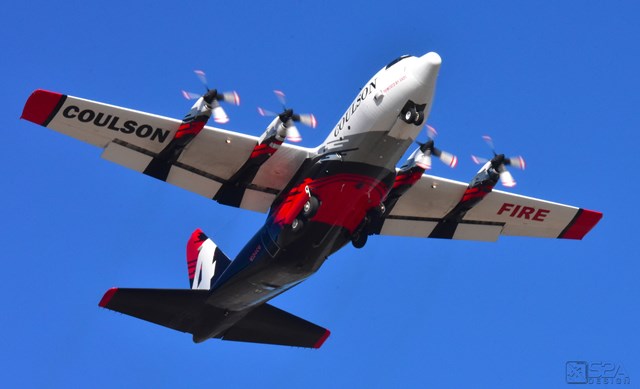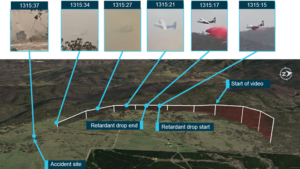Estimated reading time 6 minutes, 24 seconds.
Weather and environmental influences, aircraft performance and handling, and operating policies and procedures are among the areas of ongoing focus as the Australian Transport Safety Bureau (ATSB) continues its investigation into the collision with terrain of a C-130 large air tanker (N134CG), operated by Coulson Aviation.
Three aircrew were fatally injured when the aircraft impacted rising terrain after conducting a fire retardant drop to protect property at Peak View, New South Wales, on Jan. 23, 2020.

“The interim report does not contain findings nor identify safety issues, which will be contained in the final report. However, it does detail the extensive evidence gathered to date, which has helped ATSB investigators develop a detailed picture of this tragic accident’s sequence of events,” said ATSB chief commissioner Greg Hood.
“To-date, the ATSB has interviewed other pilots and key personnel from the aircraft operator, NSW Rural Fire Service personnel involved in aviation operations, witnesses, C-130 and other aerial firefighting pilots, and key personnel in overseas aerial firefighting operations.”
In addition, while the aircraft’s cockpit voice recorder was inoperative, the investigation team drew upon ADS-B transponder data (used for air traffic control and surveillance); data recorded by the aircraft’s SkyTrac tracking system (used for monitoring by the NSW Rural Fire Service); and video of the accident taken by firefighters on the ground, to develop an understanding of the aircraft’s flight path.
Analysis of the witness video confirmed that the aircraft initially established a positive rate of climb and was banking to the left following the retardant drop, the report details.
After climbing for about 10 seconds the aircraft was then observed to roll from a left bank to a slight right bank. A maximum height of about 330 feet above ground level was reached before the aircraft was observed descending. A further seven seconds later, the aircraft was observed at a very low height above the ground, in a left bank, before it collided with the ground.
In the video the aircraft is intermittently obscured by smoke, however, it is unclear if the aircraft flew behind the smoke or entered smoke, Hood noted.
The report also notes that at the time of the retardant drop, the aircraft’s recorded ground speed (determined from ADS-B and SkyTrac data) was 144 knots, while prior to the impact, the groundspeed had increased slightly to a maximum of 151 knots.
Hood said the ATSB’s examination of the accident site and recovered wreckage established no evidence of structural failure or pre-existing damage to the aircraft.
“All major sections of the aircraft’s structure were identified. No pre-existing airframe issues were identified, and there was no evidence of an in-flight break-up or pre-impact structural damage,” he added. “All four engines and 16 propeller blades were located onsite, and a subsequent teardown inspection of the engines indicated they were rotating at impact.”

Due to the extent of damage, the elevator, aileron and rudder trim settings could not be established. However, onsite measurements of the flap screw jacks indicated the flaps were set at 50 per cent at impact, consistent with the expected setting following a retardant drop.
The aircraft was originally tasked to conduct retardant drops at the Adaminaby fire ground. However, after conducting a number of circuits over the fire ground, the crew determined that conditions were too windy and smoky to conduct a drop. Instead, the Cooma Fire Control Centre re-tasked the C-130 to conduct a retardant drop to protect property at Peak View, about 58 kilometres to the east of Adaminaby.
Following the accident, the ATSB received multiple witness reports of the weather conditions at Peak View.
“Witnesses all consistently reported very strong winds from the north-west,” Hood said.
“One resident noted that, although the prevailing wind was from the north-west, the direction and strength at ground level were also being influenced by the local terrain.”
A private weather station, about 1.3 km from the accident site, had recorded winds from the west of 15-16 knots, with a peak gust from the north-west of 43 knots.
Hood said a Bureau of Meteorology analysis of the weather conditions on the day of the accident indicated that a cold front was approaching the accident location, with hot and strong north to north-westerly winds ahead of the front.
“The Bureau of Meteorology considered the conditions on the day were favourable for mountain wave development, and satellite imagery of cloud formations confirmed their presence in the general area of the accident,” he said.
“However, from the data available they were unable to determine the severity of mountain wave activity.”
The interim report also notes that the flight crew were appropriately licenced and endorsed, held valid medical certificates, and that there no indications they were fatigued. However, there was insufficient information available to the ATSB about the crew members’ sleep and non-duty activities to estimate fatigue levels with confidence.
“The investigation is continuing. However, should a critical safety issue be identified during the course of the investigation, the ATSB will immediately notify relevant parties so appropriate and timely safety action can be taken,” Hood said.








